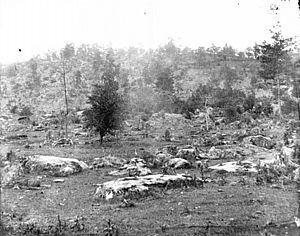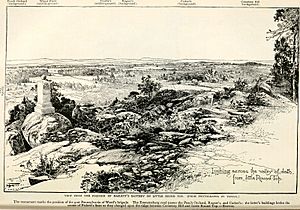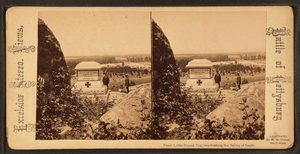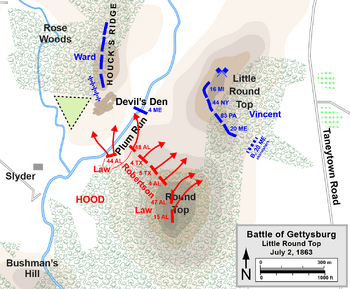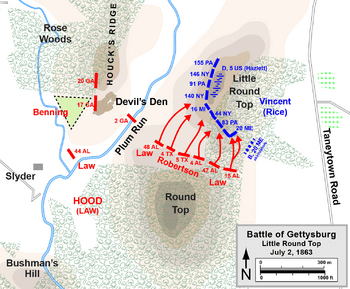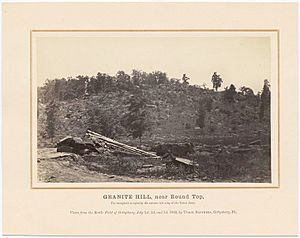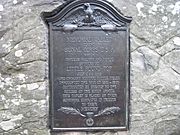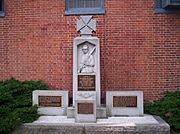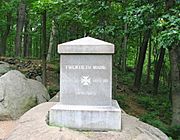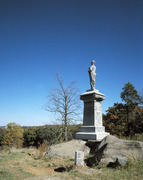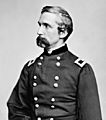Little Round Top facts for kids
Quick facts for kids Little Round Top |
|||||||
|---|---|---|---|---|---|---|---|
| Part of the Gettysburg Campaign | |||||||
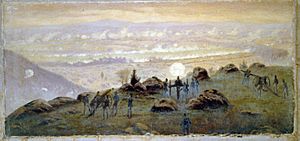 "View from the summit of Little Round Top at 7:30 P.M. July 3rd, 1863", painting by Edwin Forbes |
|||||||
|
|||||||
| Belligerents | |||||||
| Commanders and leaders | |||||||
|
|
||||||
| Strength | |||||||
| 2,996 troops | 4,864 troops | ||||||
| Casualties and losses | |||||||
|
|
||||||
Little Round Top is a smaller, rocky hill located south of Gettysburg, Pennsylvania. It sits next to a taller hill called Big Round Top. On July 2, 1863, during the second day of the Battle of Gettysburg in the American Civil War, Confederate soldiers tried to capture Little Round Top but failed.
This important hill was successfully defended by a group of Union soldiers led by Colonel Strong Vincent. He was badly wounded during the fight and died a few days later. The 20th Maine Volunteer Infantry Regiment, commanded by Colonel Joshua Lawrence Chamberlain, fought its most famous battle here. They ended up making a dramatic charge down the hill with bayonets. The battle at Little Round Top became one of the most well-known events of the entire war.
Contents
About Little Round Top
Little Round Top is a large, rocky part of Big Round Top. It has an oval top, even though its name suggests it's round. It's about two miles (3 km) south of Gettysburg. The hill has a rough, steep side that rises about 150 feet (46 m) above a nearby stream called Plum Run. This side is covered with large boulders. The top of the hill is about 650 feet (198 m) above sea level.
Historically, the western side of the hill had little plant life. The top and the eastern and southern sides had light woods. Big Round Top, which is 130 feet (40 m) taller, is located directly south and is covered in dense woods.
During the battle, soldiers and civilians didn't commonly use the name "Little Round Top." People called it by different names like Rock Hill, High Knob, or Sugar Loaf Hill. Historian John B. Bachelder preferred "Weed's Hill," named after Brigadier General Stephen H. Weed, who was killed there. However, the name "Little Round Top" became official after Edward Everett used it in his speech at the dedication of the Gettysburg National Cemetery in November 1863.
The Battle for Little Round Top
On July 2, 1863, the second day of the Battle of Gettysburg, Confederate forces launched a major attack. Around 4 PM, Confederate Lt. Gen. James Longstreet's troops began their advance. Their goal was to move northeast and attack the Union army's left side.
However, some of Longstreet's troops, from Maj. Gen. John Bell Hood's division, accidentally moved too far east. Instead of staying on the main road, they headed towards the Round Tops. This happened for a few reasons: Union troops were unexpectedly in the area, some Confederate units chased Union sharpshooters, the ground was very rough, and the Confederate commander, General Law, didn't know he was in charge of the division after Hood was wounded.
Meanwhile, Little Round Top was almost empty of Union soldiers. Maj. Gen. George Meade, the Union commander, had ordered his III Corps to defend the area. But Maj. Gen. Daniel Sickles, who led the III Corps, moved his troops forward to a different position. This left Little Round Top unprotected.
When General Meade found out, he sent his chief engineer, Brig. Gen. Gouverneur K. Warren, to check the situation. Warren climbed Little Round Top and found only a small group of Signal Corps soldiers there. He saw the sunlight reflecting off Confederate bayonets in the distance. He quickly realized that a Confederate attack on the Union's unprotected side was about to happen. He immediately sent officers to find help.
Help came from Maj. Gen. George Sykes, who commanded the Union V Corps. Sykes sent a message to his 1st Division to go to Little Round Top. But before the message reached the division commander, Colonel Strong Vincent took action. He was a brigade commander and decided to lead his four regiments to Little Round Top without waiting for orders. He and his bugler, Oliver W. Norton, rode ahead to guide his troops.
When Vincent's men arrived, they were immediately fired upon by Confederate cannons. Vincent quickly placed his regiments on the western slope of the hill. From right to left, he positioned the 16th Michigan, the 44th New York, the 83rd Pennsylvania, and finally, at the very end of the line on the southern slope, the 20th Maine. They arrived only ten minutes before the Confederates. Vincent ordered his brigade to take cover and wait. He specifically told Colonel Joshua Lawrence Chamberlain, commander of the 20th Maine, to hold his position, which was the very end of the Union line, no matter what. Chamberlain and his 385 men waited for the attack.
The Fight for the Hilltop
The Confederate attackers were from the Alabama Brigade, led by Brig. Gen. Evander M. Law. His men were very tired, having marched over 20 miles (32 km) that day in the hot sun with empty canteens. Law ordered his men to take the hill. When they reached the Union line, they were pushed back by the first Union gunfire and had to regroup. The 15th Alabama, led by Col. William C. Oates, tried to go around the Union's left side.
The Union's left side was held by the 386 men of the 20th Maine and the 83rd Pennsylvania. Seeing the Confederates trying to get around his flank, Chamberlain stretched his line of men as far as it could go. Then, during a break in the fighting, he ordered the southernmost part of his line to swing back. This created an angle, like a door closing, to stop the Confederates from getting around them. Even with many losses, the 20th Maine held their ground against two more attacks from the 15th Alabama and other Confederate regiments for 90 minutes.
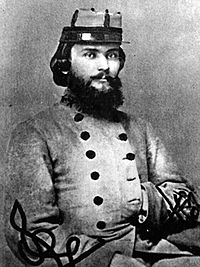

Chamberlain knew his men were running out of ammunition and losing too many soldiers. He realized they couldn't stop another Confederate charge. So, he gave a famous order: fix bayonets and counterattack! He told his left flank, which was pulled back, to advance forward. As soon as they were in line, the rest of the regiment would charge like a swinging door. This surprise attack, hitting the Confederates from the front and side at the same time, stopped and captured many of the 15th Alabama soldiers.
As the Confederates retreated, they were hit by gunfire from Company B of the 20th Maine, led by Captain Walter G. Morrill. These men, along with some U.S. Sharpshooters, had been hidden behind a stone wall. Their surprise fire caused a lot of confusion among the retreating Confederates.
Thirty years later, Chamberlain received the Medal of Honor for his brave actions at Little Round Top.
Even with this victory, other Union regiments on the hill were in great danger. While the Alabamians attacked the Union left, the 4th and 5th Texas regiments attacked Vincent's 16th Michigan on the Union right. Colonel Vincent, who was rallying his small regiment, was badly wounded during a Texas charge. He died on July 7, but not before being promoted to brigadier general. Colonel James C. Rice took over command.
Before the Michigan soldiers could lose hope, help arrived. General Warren, who had continued to find more troops, sent the 140th New York and a battery of four cannons. Moving these cannons up the steep, rocky hill by hand was an amazing feat. The 140th New York charged into the fight, pushing the Texans back and securing the victory for the Union on the hill. Their leader, Colonel Patrick "Paddy" O'Rorke, was killed leading the charge.
More Union troops reinforced the hill, and they held it for the rest of the battle. They faced constant fire from Confederate sharpshooters. General Weed was killed, and as his friend Charles Hazlett leaned over to help him, Hazlett, an artilleryman, was also shot and killed.
After the Main Fight
Later that day, Little Round Top saw continuous small skirmishes. Union troops built stone walls for defense, many of which can still be seen today.
On July 3, cannons on Little Round Top fired into the side of the Confederate attack known as Pickett's Charge. Near the end of that battle, General Meade watched from Little Round Top and thought about his next moves.
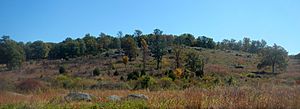
Why Little Round Top Mattered
Out of 2,996 Union soldiers who fought at Little Round Top, 565 were killed, wounded, or went missing. The Confederates had 4,864 soldiers engaged, with 1,185 killed, wounded, or missing.
Historians have different ideas about how important the battle for Little Round Top was to the overall outcome of Gettysburg. Some believe it was a crucial position. They argue that if the Confederates had captured the hill and brought up their cannons, they could have fired down the entire Union line, making it impossible for the Union army to stay there.
Others argue that the hill wasn't a good place for cannons. They think that if the Confederates had taken the hill, the Union army would have just moved to a better defensive spot. General Lee's own writings suggest he didn't see Little Round Top as a main goal. He described his troops as being "delayed by" the hill, not that it was their main objective.
Historian Garry Adelman points out that even if Confederates had captured the hill, they would have been tired and low on ammunition. Meanwhile, many fresh Union troops were nearby and could have easily retaken it. Also, the shape of the hilltop made it hard to place cannons effectively.
While Joshua Chamberlain and the 20th Maine are very famous, other brave figures like Strong Vincent, Patrick O'Rourke, and Charles Hazlett also played equally important roles in the Union's success at Little Round Top. Their deaths during the battle meant their stories were not as widely told.
After the War
After the Civil War, many generals visited Little Round Top. Markers were placed to show important spots. An observatory was built by 1886, and a stone monument for the 44th New York was dedicated in 1892. In the late 1880s, the 20th Maine Volunteer Infantry Regiment monument was dedicated, with a speech by Joshua Chamberlain.
In 1935, parts of the road on Little Round Top were changed to create a bypass. A parking lot was also built at the summit around this time.
- Monuments at Little Round Top
-
The 20th Maine Volunteer Infantry Regiment monument on Little Round Top is the most popular Gettysburg National Military Park monument that visitors request to see.
Little Round Top in Pop Culture
The battle for Little Round Top is a key part of the 1953 novel Bring the Jubilee. The 1974 novel The Killer Angels and its 1993 movie, Gettysburg, also show parts of this battle. Filmmaker Ken Burns praised Chamberlain in his PBS documentary The Civil War for possibly saving the Union with his actions.
In the 2016 song "Ballad of the 20th of Maine" by the folk group The Ghost Of Paul Revere, the famous bayonet charge is described: "Well, our western flank was missing / As the confederates pushed on / And we fought them tooth and nail / Our ammunition all but gone ... Then appeared our lion roaring bayonets / Charging down the mountain with what soldiers we had left / We were steadfast as katahdin, hard as winters rain".
Images for kids
-
Joshua Lawrence Chamberlain ordered the bayonet charge on Little Round Top.
See also
 In Spanish: Little Round Top para niños
In Spanish: Little Round Top para niños




